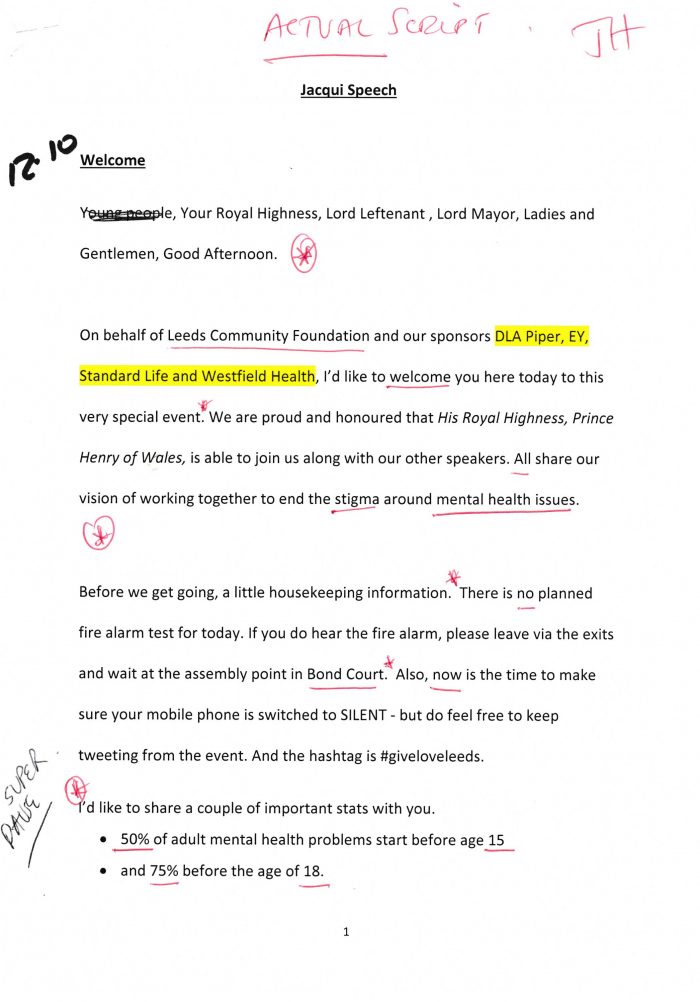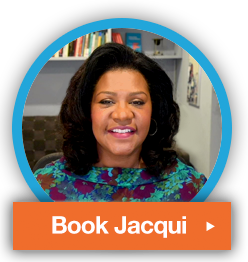When Jacqui met Harry … or Six Tips to Speak with Scripts
I’ve spoken at hundreds of conferences yet when asked to share a platform with Royalty I was SO nervous! I sorted out my nerves by writing a professional script.
It worked; the conference organiser described my presentation as “assured, business-like and warm”. This blog shares techniques to speak well with scripts.
- Rewrite
The goal is to get the script to sound as close as possible to your speaking voice. The success of the presentation is down to how effectively you write or rewrite the script to sound ‘natural’.
The conference organisers wrote a script for me to introduce the conference, introduce the guests and to close the conference. The content of the script was excellent but the language didn’t sound like me. My first task was to transform the script to ‘Jacqui speak’.
As I sat at my laptop going through the script I was constantly reading the words out loud to hear how the language sounded and testing whether it felt like something I would actually say. This is a practice I learned in TV newsrooms.
I shortened the sentences so they were easier to say and therefore easier to communicate the meaning.
I changed words so the tone was more conversational. For example, after showing a video clip of young people talking about mental health I had to say a back anno (TV speak for a back announcement, that is, a short comment after a video).
The original script said:
Thank you to these incredible people, who are here today, for sharing their very personal stories.
The rewritten script:
Such incredible young people. Thank you for sharing your stories. And it’s great to have you here today.
I used contracted versions of familiar phrases for example, ‘I have’ was changed to I’ve and ‘we are’ was changed to ‘we’re’.
I used ‘set up’ phrases to introduce important ideas before actually saying them. For example there was data on mental health that I wanted the audience to really notice. I prefaced the data by saying “I’d like to share a couple of important stats with you”.
Double line spacing makes a script so much easier to navigate in a live situation. It means when looking up and down from the script it is easy to find your place and keep regular eye contact with the audience.
I have occasionally seen speakers falter (and worse) when their script pages come out of order. One solution is to staple the scripts or link them together with a Treasury Tag. The only drawback to this option is that a sensitive mike will pick up the sound of the pages being turned and they will also be more visible to the audience.
Another option is to number the script pages and hold them together with a paper clip. At the podium remove the paper clip so you can slide the pages right to left as you are reading. This keeps paper-shuffling sound to a minimum and is less visible to the audience. This is how I’ve handled scripts when broadcasting live on television.
2.Rehearse
Once I got the script sounding right I moved onto rehearsals. In my office I stood up to read scripts all the way through – several times. The point was to become comfortably familiar with the script but not to the point of knowing it by heart.
3.Mark up the script
After several run-throughs I returned to my desk and the script. This time my goal was to use annotations to enhance my presence and impact. There are many ways to do this and I encourage you to create a system that works for you. My system included underlining words that needed vocal emphasis. I inserted an asterix where I wanted to remind myself to pause within a paragraph.
I circled an asterix to prompt me to do a ’superpause’. This is a longer pause that separates one key idea from another. It allows the speaker to breathe, the audience to process the information and it signals to the audience that a new, key idea is about to start.
I highlighted in yellow the names of the sponsors so their name checks were given sufficient vocal weight.
See below for the first page of my conference script and the mark up I did.

- Fine tune
Then it was back to rehearsals to fine tune my performance. This time I recorded the rehearsals to review what needed adjusting. For the first rehearsal I recorded sound only to assess how fluently I came across and to gauge the expressiveness in my voice.
The second run-through I just watched the vision and muted the sound. I was checking my body language, gestures, facial animation etc.
On the last rehearsal I reviewed both sound and vision. By this time I was happy and comfortable with the script.
I was able to do a full walk-through at the venue the day before. I used the opportunity to ‘own the space’. This is a combination of breathing into the space, testing mikes and walking to and from the podium.
- On the day!
In the early morning I read through the scripts a couple of times in private. On the day of an event it’s amazing how the adrenalin suddenly kicks in and makes you feel as if you haven’t done any preparation at all. The solution is to focus on the start of the speech.
It’s when the audience is most attentive and when the rapport between speaker and audience is established. It’s also when a speaker is most likely to be nervous. For this reason I recommend going over the beginning of the script as many times as you need. I went through my opening FIVE times in private!
6. BLAB
BLAB is my acronym for:
- Breathe
- Look
- And
- Begin
This deceptively simple technique makes a dramatic difference. It helps a speaker start in control and look poised and confident. It certainly helped me.
To BLAB a speech you walk purposefully towards the podium without speaking. (I see too many instances of speakers diminishing their impact while walking and talking before they get to the podium). When you arrive at the podium you pause and breathe deeply, look into the audience and then begin.
With all that preparation behind me I was finally ready for The Prince!
——————————————————————————————————————————————————————————————————————————–
Jacqui Harper MBE MA Hon Fellow
Jacqui is a visiting professor at INSEAD – the number one global business school (Financial Times, 2017) where she teaches Executive Presence to MBA students and executives.
As a TV news anchor Jacqui has presented several news programmes for BBC TV, Sky News and ITV and a chat show on BBC 2.
Her presenting experience gives her many practical insights and skills to share with business leaders needing high grade communication skills at conferences, board presentations, media interviews and stakeholder events.
Through her company, CRYSTAL BUSINESS COACHING, she has been transforming Executive Presentations for over fifteen years and her clients include many CEOs of global corporations and senior staff at The Foreign Office.
Jacqui has a passion for writing. It started as a business reporter for the Oakland Tribune in California. She has written a business book called The Professional’s Guide to Presentations. She is currently writing a new book on Executive Presence.
Jacqui is married to Peter, a lawyer, and they have two gorgeous kids who are at school. Jacqui’s free time is spent walking in The Yorkshire Dales.
Tags: crystal business coaching, jacqui harper, Prince Harry, public speaking
Categorised in: Communication, Conference Speaking, Executive Presence, Public Speaking

